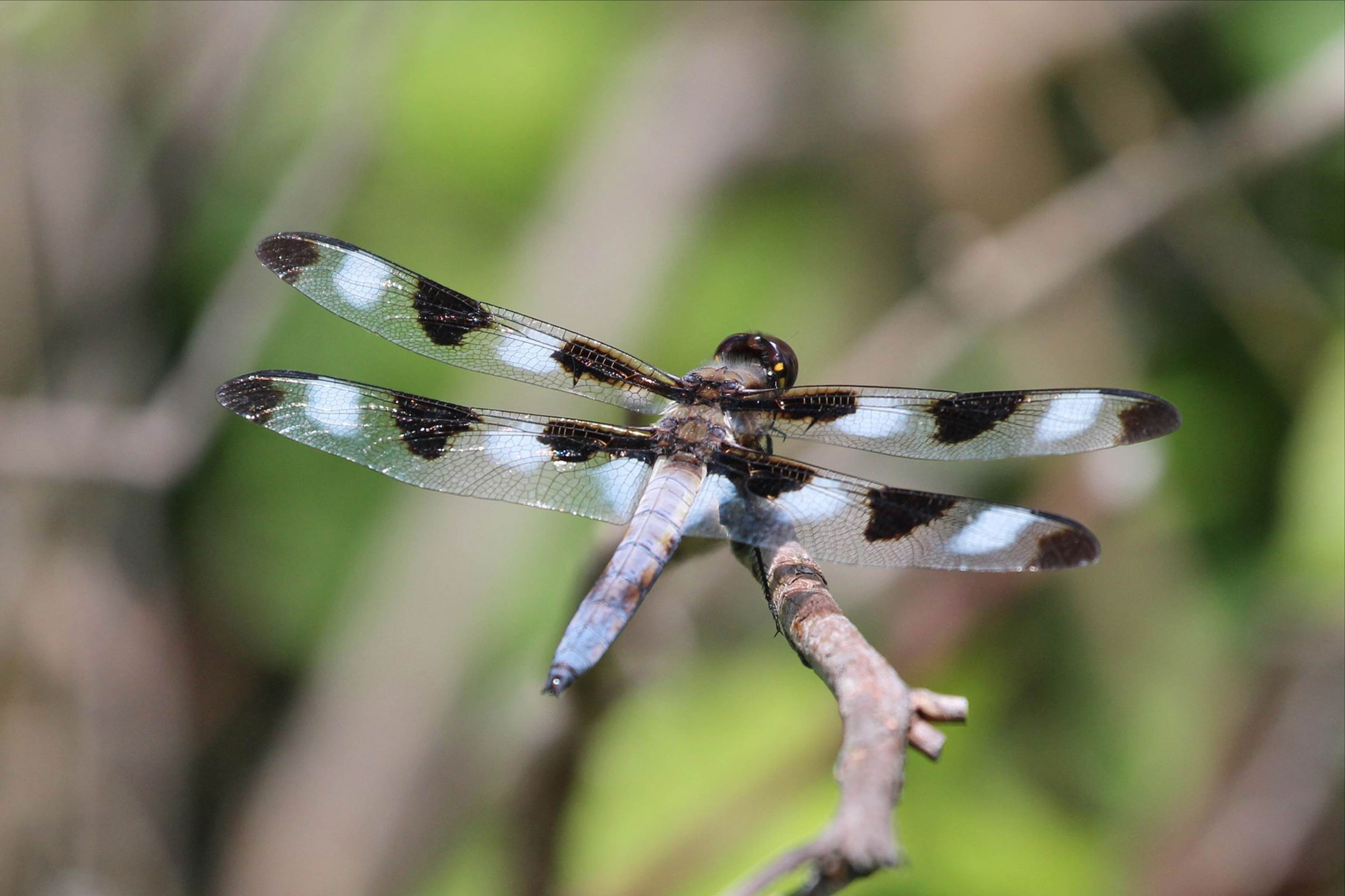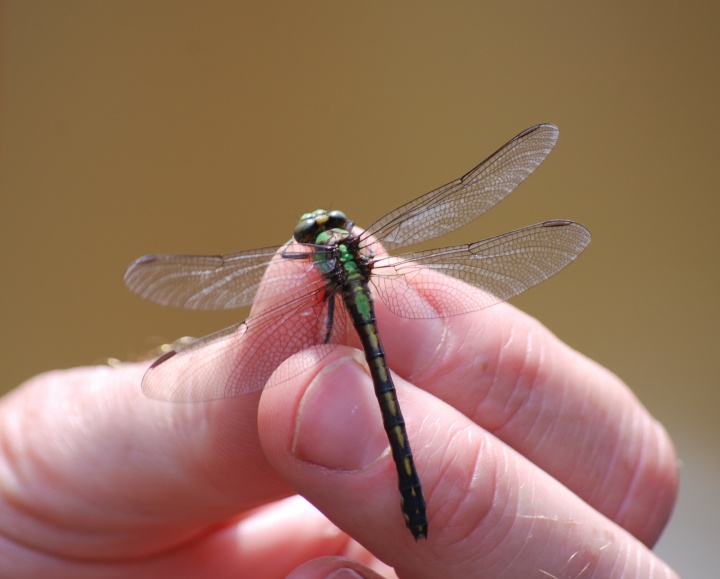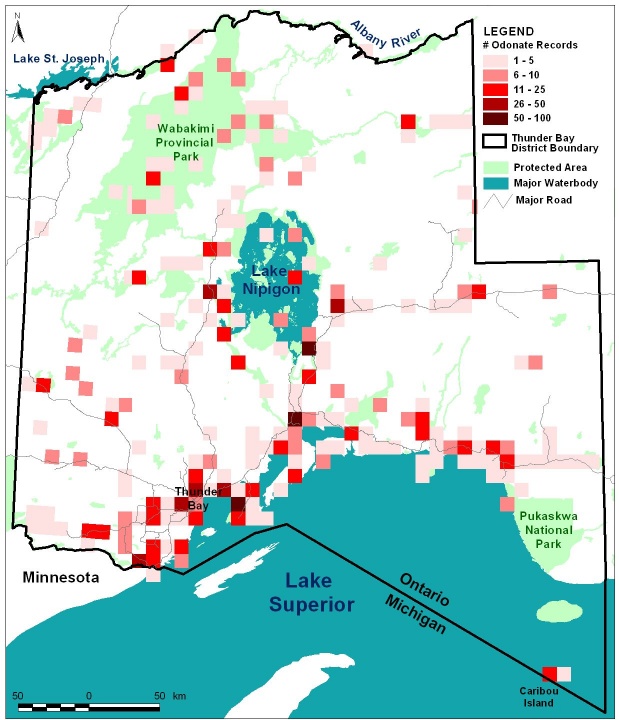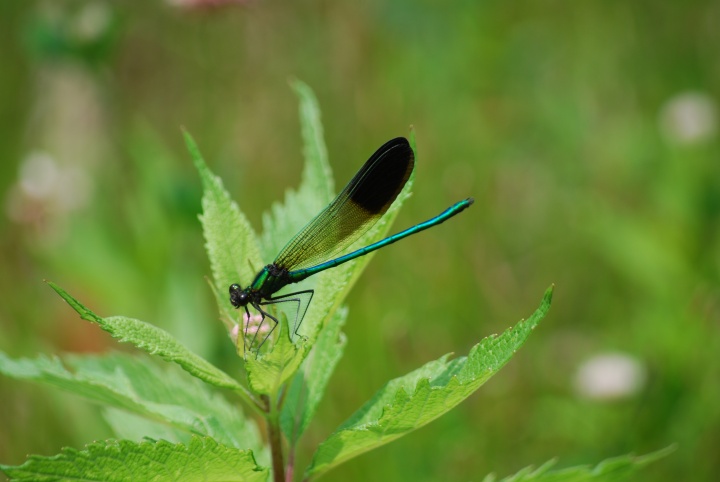Dragonfly and Damselfly Checklist
Introduction
The following is an annotated checklist of the odonates (dragonflies and damselflies) known from Thunder Bay District in northern Ontario as of March 2010. It builds upon the work of Catling and Brownell (2000), who compiled annotated lists of odonates for all of Ontario’s counties and districts. The Thunder Bay Judicial District extends from Lake St. Joseph in the northwest, south to Quetico Provincial Park, east along the Albany River, and south to Caribou Island in Lake Superior (see map). A total of 82 species of odonates (63 dragonflies and 19 damselflies) are known from the district, but there are likely a number of resident species yet to be discovered.
Background
The checklist is based on over 1700 records between 1907 and 2009, most of which are captured in the Ontario Odonata Atlas (OOA 2009). Over 400 of the records predate WWII, most of them by E.M. Walker (University of Toronto), N.K. Bigelow, and G.K. Jennings (Carnegie Museum). For the next 50 years, there were only a dozen or so new observations of dragonflies and damselflies reported for the Thunder Bay District, until a resurgence of interest by a new generation of enthusiasts in the mid-1990s. Since 1995, there have been over 1200 new records for odonates in the Thunder Bay District and almost 20 new species recorded for the district. Many of these recent records are from life science inventories conducted in protected areas (see map) and from surveys conducted by TBFN members and staff from OMNR’s Natural Heritage Information Centre.
The Checklist
Standardized English common and scientific names are from The Odonata of North America (Paulson and Dunkle 2009). Family order follows Paulson and Dunkle (2009) and species scientific names are listed alphabetically for convenience.
Notes are provided where known on the distribution, abundance, and habitat associations within the Thunder Bay District.
Descriptions of species abundance generally follow those categories used by Jones et al. (2008) where:
Common species are those that are likely to be found with minimal effort when visiting the appropriate habitat at the appropriate time of the year, and are usually found in multiple habitats.
Uncommon species are those that occur in low numbers and/or are associated with a specialized habitat. By knowing the habitat and searching at the right time of the year, however, they can usually be located.
Rare species are those that always occur in low numbers and/or are only known from a few sites. At these sites, however, they can be very numerous at the right time of year. These species are almost always restricted to a particular habitat.
Very Rare species are those that have been seen in the region very occasionally, perhaps only once. Although breeding may not be confirmed, they are at least likely breeding in small numbers at one or a few sites.
Migrants are those species that may breed in our district but that typically do not overwinter here as eggs or larvae. Rather, the adults migrate south in the fall where they usually breed. The fully mature offspring from these individuals are those that may return to our region the following spring. Most migratory odonates in our district are classified as irregular meaning that they may not occur every year.
Vagrants are usually seen rarely in the region and would not likely persist at a site due to a lack of suitable breeding conditions or other life history requirements of the species.
Widespread species are found throughout the district (perhaps commonly or uncommonly), but localspecies are restricted to certain locales (usually uncommon or rare species), perhaps as a result of sparsely disturbed habitat.
* denotes provincially rare species, ranked S1 to S3 by the Natural Heritage Information Centre
N refers to the number of Thunder Bay District records for a species.
Recommended Reading (click to expand)
Field Guides
Dubois, B. 2005. Damselflies of the North Woods. Kollath-Stensaas Publishing, Duluth, MN.
Dunkle, S.W. 2000. Dragonflies through Binoculars. Oxford University Press. New York, NY, USA.
Jones, C.D., A. Kingsley, P. Burke, and M. Holder. 2008. Field Guide to the Dragonflies and Damselflies of Algonquin Provincial Park and the Surrounding Area. The Friends of the Algonquin Park.
Lam, E. 2004. Damselflies of the Northeast. Biodiversity Books, Forest Hills, NY, USA.
Mead, K. 2003. Dragonflies of the North Woods. Kollath-Stensaas Publishing, Duluth, MN.
Other Publications
Catling, P.M. and V.R. Brownell. 2000. Damselflies and Dragonflies (Odonata) of Ontario: Resource Guide and Annotated List. Toronto Entomologists Association, Toronto, Canada. ISBN 0-9682013-1-8.
Catling, P.M., C.D. Jones and P. Pratt, eds. 2000-2006. Ontario Odonata. Vols 1-7. Toronto Entomologists Association, Toronto, Canada. Available from www.ontarioinsects.org.
Needham, J. G., M. J. Westfall, and M. L. May. 2000. Dragonflies of North America. Scientific Publishers, Gainesville, FL, USA. ISBN 0-945417-94-2.
OOA (Ontario Odonata Atlas). 2009. Natural Heritage Information Centre, Ontario Ministry of Natural Resources. Thunder Bay District records queried on 16 Oct. 2009 by C.D. Jones
Paulson, D.R. and S. W. Dunkle. 2009. A Checklist of North American Odonata including English Name, Etymology, Type Locality, and Distribution. Available at http://www.odonatacentral.org/docs/NA_Odonata_Checklist_2009.pdf
Walker, E. M. 1953. The Odonata of Canada and Alaska, Volume I. General and Zygoptera. University of Toronto Press, Toronto, Canada.
Walker, E. M. 1958. The Odonata of Canada and Alaska, Volume II. Anisoptera – Four Families. University of Toronto Press, Toronto, Canada.
Walker, E. M. and P. S. Corbet. 1973. The Odonata of Canada and Alaska, Volume III. Anisoptera – Three Families. University of Toronto Press, Toronto, Canada.
(The above three volumes by Walker et al. are available from the Toronto Entomologists Association www.ontarioinsects.org).
Westfall, M. J. and M.L. May. 1996. (revised 2005) Damselflies of North America. Scientific Publishers, Gainesville, FL, USA. ISBN 0-945417-93-4.
Acknowledgements
Data from the Ontario Odonata Atlas was generously provided by the Natural Heritage Information Centre (NHIC), Ministry of Natural Resources. Colin Jones was particularly supportive of this endeavour, including reviewing a draft version of the checklist. Other NHIC staff (Michael Oldham, Don Sutherland, and Wasyl Bakowsky) shared unpublished data as well. Sue Bryan of the Thunder Bay Field Naturalists generously provided numerous district records. Steve Kingston and Ontario Parks contributed odonate records from the Ontario Parks Inventory and Monitoring (OPIAM) database.




